Finally a journalist from The ABC has acknowledged the economic elephant in the room: that Australia’s so-called economic out-performance over the past decade or so has been driven, to a great extent, by its world-beating immigration program, which has not raised individual living standards:
Australia has ridden 25 years of economic growth without a recession…
But often underappreciated is the role that migration has played. A huge increase in migration has fuelled headline GDP growth, keeping Australia technically out of recession. But, it’s also masked a dirty secret, individuals haven’t felt the benefit of this record run…
Much of it fuelled by “temporary” migrants, many of which are not captured in these numbers.
These include some students, 457 workers, working holiday and bridging visa holders – who are generally able to work and many of whom end up staying in the country permanently…
Overall Australian population growth has averaged 1.7 per cent over the last decade – that’s more than double the rate in the US over the same period.
Despite the political heat surrounding “boat people” and asylum seekers, there has been bipartisan support for a huge increase in migration to Australia for a long time…
It’s a very simple equation: more people means more economic activity and that gives the government of the day an easy way to keep crowing on about good economic management.
But more people does not mean that the living standards of the existing population also rise. In fact, it can have detrimental economic effects for the people who are already here.
New workers mean greater competition for jobs, which suppresses wages…
More people also mean more demand for scarce goods and services. When there’s already a tight supply of a particular good, it can mean huge price rises…
Perhaps the most illustrative example is housing, where prices continue to rise sharply in Australia’s two biggest magnets for new migrants, Sydney and Melbourne, putting them outside the reach of many first home buyers…
The reason why many people feel that they haven’t benefitted from the Australia’s long stretch of economic expansion, is quite simply because they haven’t.
Their pay packets haven’t gotten bigger while the cost of essential goods like shelter have risen.
High migration makes it nearly impossible for Australia to fall into recession.
The economy keeps getting bigger just because there are more people operating in it.
It’s great for business, because it keeps wages low and there’s more people to buy stuff from them.
It’s great for governments because it means economic growth looks better than it otherwise would.
But it isn’t necessarily good for ordinary workers.
As new Reserve Bank governor Philip Lowe has noted, the role of good economic policy should be to “raise living standards” – not just make the population, and therefore economy, bigger.
Well said.
Australia’s population has grown at 2.5 times the OECD average since 2003 on the back of mass immigration (see below charts).
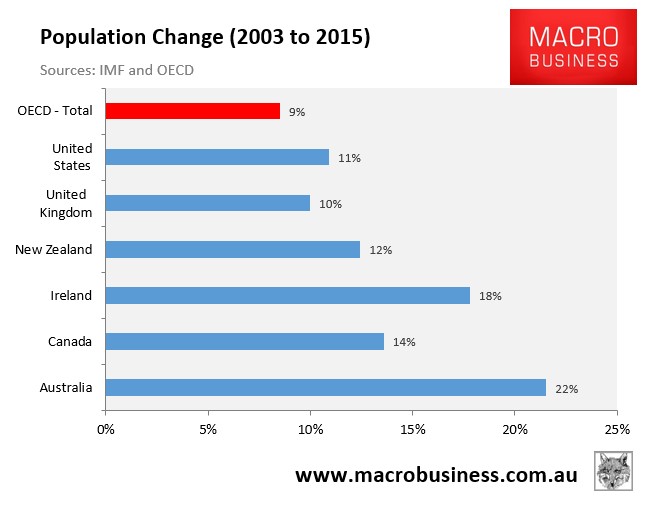
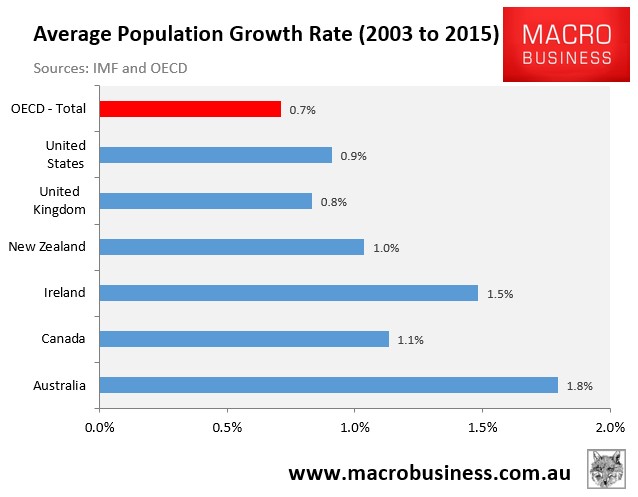
While the federal government regularly claims credit for Australia’s quarter century of uninterrupted growth, the situation is far less flattering when the economy is considered on a per capita basis, with the economy actually sliding backwards in two of those years (see next chart).
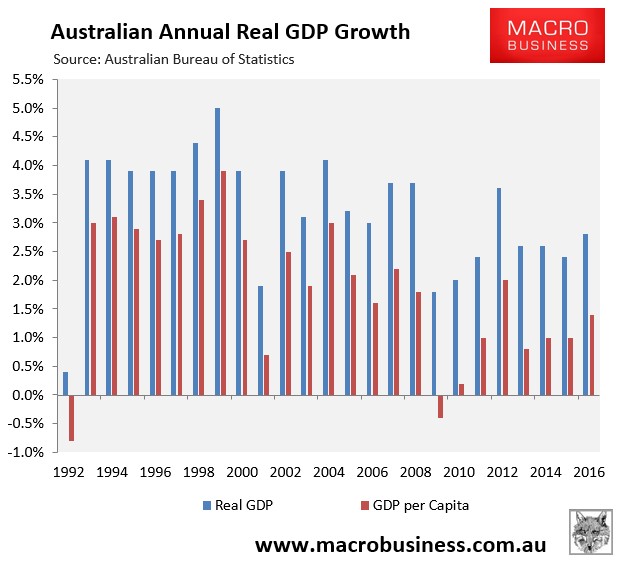
The national accounts clearly show that Australia’s economy is growing largely because of strong immigration and population population growth. Remove these from the equation and Australia’s per capita GDP growth has been very poor (see next chart).
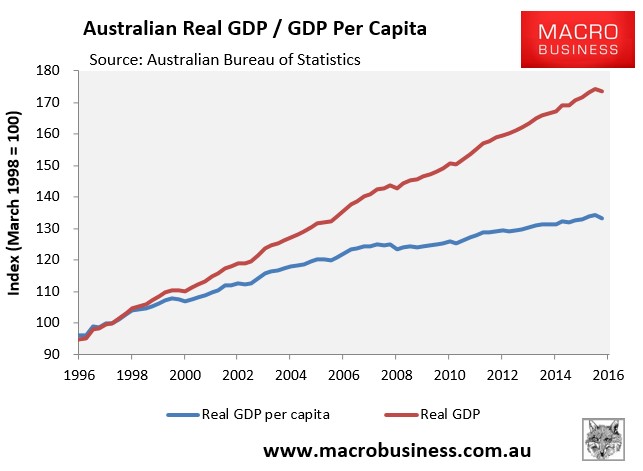
In fact, Australia’s 10-year annualised growth in per capita GDP is tracking at its lowest level since December 1983 – i.e. even worse than the early-1990s recession (see next chart).
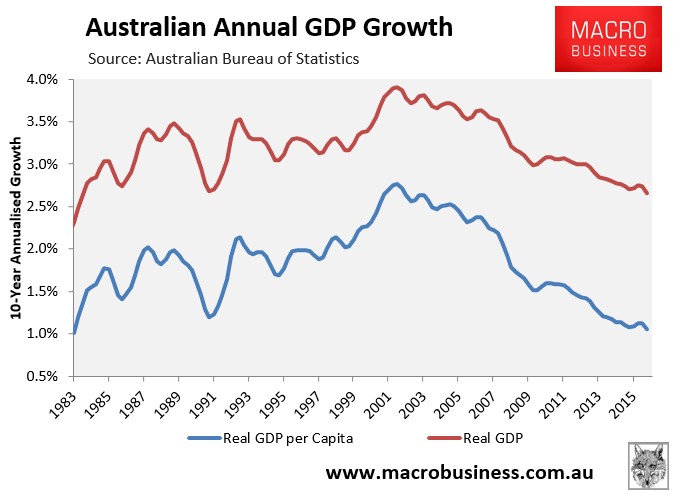
Moreover, Australia’s per capita GDP growth since the GFC has been far worse than after the 1970s, 1980s and 1990s recessions:
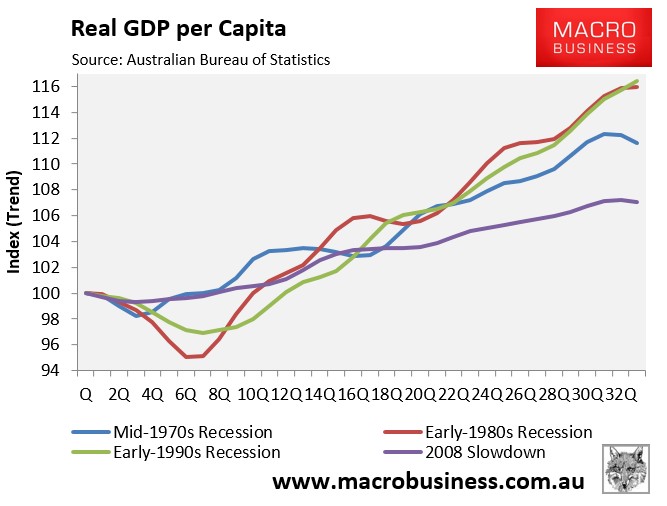
33 quarters after the onset of the GFC, GDP per capita has risen by only 7.1%. This compares to 11.6% growth after the same point following the mid-1970s recession, 16.0% growth after the early-1980s recession, and 16.5% growth at the same point following the early-1990s recession.
If you add negative externalities like increased congestion, reduced housing affordability, reduced environmental amenity, the dilution of Australia’s fixed mineral endowment, and rising inequality – which are not properly captured in real GDP per capita – it is obvious that incumbent living standards are being made worse-off via mass immigration.
The crazy thing is that the official government projections are for Australia’s population to grow by 400,000 people per annum over the next 40 years, almost entirely via immigration:
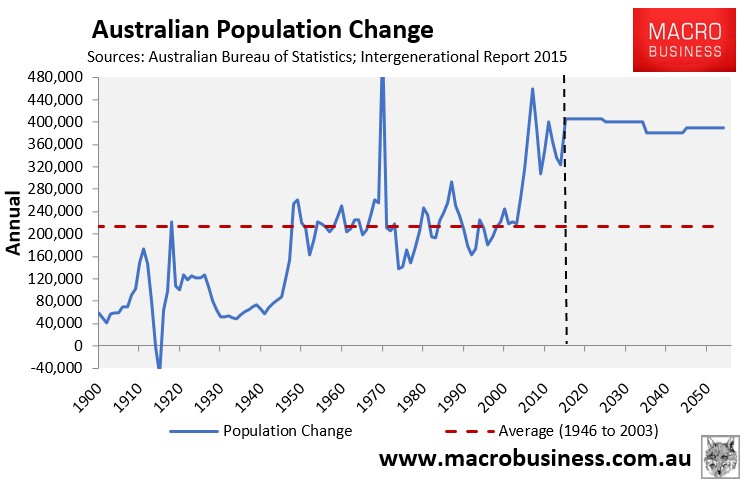
This is the equivalent of adding a Melbourne to Australia’s population each and every decade! To quote former Treasury secretary, Ken Henry:
“The Australian population is growing by something like 400,000 a year. Think of it: a new Canberra every year between now and the end of the century. Or, put it this way, every five years building a brand new city from scratch in Australia for 2 million people.”
“Or put it this way: building a whole new city the size of Melbourne every decade between now and the end of the century”…
“My observation in Sydney and Melbourne today, is that people already think, with very good reason, that the ratio of population to infrastructure is too high. But we have set ourselves on a journey that implies an increase in that ratio. An increase in that ratio that is associated with more congestion, longer commute times to work, increasing problems with respect to housing affordability”…
While mass immigration policy has been effective at masking Australia’s economic decline – by juicing headline GDP – it is equally effective at eroding incumbent residents’ living standards.
In case you missed it, I analysed these issues in great detail in my recent presentation on the economic impacts of immigration.

